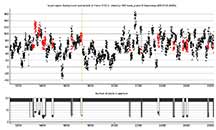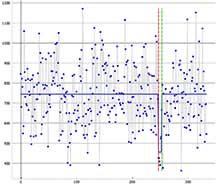The Occultation of a 15.0 star by the Asteroid Deiphobus
June 10, 2021 at 2:51:21am
The asteroid is in a dense star field in Sagittarius, but fortunately very close to a globular cluster which should help in ID'ing the field. The 8.4 magnitude globular is NGC 6569. The altitude of the target is 20 degrees, at azimuth 189, nearly due south. The 14.1 combined image will require long integration to see, but fortunately the occultation should last up to 7 seconds.
Results:
Kirk and I both got recordings, as did Tony George in Arizona).
Nolthenius Results:
My light curve is below, using PyMOvie. There may be a second start of about 14.8 magnitude? inside the aperture of the target star, but not sure. It would then reduce the brightness drop expected if true, and very very likely to undetectability even if a long event. I just don't have enough signal to say much. I don't plan to report my results at this moment... but will wait.
My dialog with Tony (Tony in italics) on PyMovie use...
- If I'm doing a very faint star so there's danger when specifying 'snap to blob' that it'll be snapping to a wrong star or random noise excursion pixel(s) yes for faint stars, this is a possibility. You can ameliorate this by increasing the mskth value so the blob is only created when the star is clearly above background. When the star is too faint for a blob to be formed, PyMovie defaults to a static aperture. This is evident in the target plot in that blob readings are red dots and static aperture readings are black triangles, I should specify 'static' to avoid this? Is 'static' the same as "linked" in LiMovie. A yellow tracking aperture creates the same effect as linked in Limovie. You must use a snap-to-blob aperture in a yellow aperture or it will not track the star movements. I did seem to get a much more stable aperture that stayed on my target star during the entire 5 minutes of video, than when I used 'snap to'.
- If I specify a tracking star (yellow) and yet use 'snap to', it would seem to me that it's not really using the tracking feature to hold rigid the position of the aperture, and so it's not really tracking in the sense I'm used to. Not true. The crosshairs in a yellow snap-to-blob aperture will always be centered on the blob centroid. This is why PyMovie works so much better for wind-shake videos than either Limovie or Tangra. So, perhaps 'static' is what I should always be using unless my target is bright enough there's no danger that 'snap to' will wander to a wrong star
- It seemed to me that in a fair number of cases of the visible aperture in the solid yellow box below the video frames, that there was a second star to the right, fainter, than the target, just a couple of pixels away. So close it's impossible to exclude it. (WikiSky disagrees. There's apparently no such star. My "star" must have been a random intermittant noise)
-
Kirk Bender and Tony's Results:
Found a dip at about the right time, but it is only "suggestive" and fails the strict significance test in PyOTE. My data was a bit poorer at my location, and I didn't see anything in PyOTE. Kirk's raw PyMOVIE photometry doesn't really show much either. Tony's recording shows no dip at the predicted time, and all 3 of our chords were pretty close together. It doesn't lean much towards either an event or a miss, and even if it was an event, it fails significance and so should not be reported as either, but rather just informally as "inconclusive". At 15th magnitude it was just too faint and short and at too low an altitude in scintillation conditions to really expect more than we got.

Kirk's PyMovie light curve, does not show an obvious event |

A possible event, at about the right time, but too long (predicted maximum duration was 7 sec, this event was 9 sec, and fails significance). |
 |

Tony's PyOTE record, with his best candidate for an event, but it was ~9 sec away from the predicted time, and did not line up with Kirk's possible 9 sec long occultation a short chord cross-track distance away. Not consistent. |







